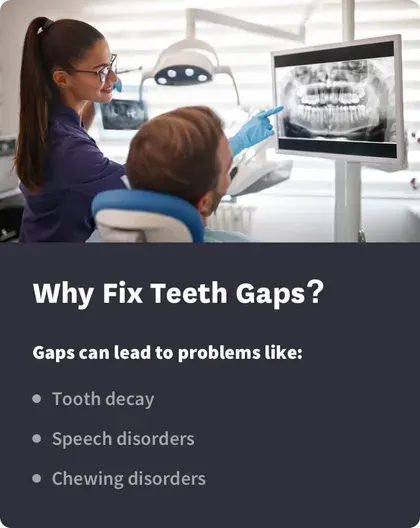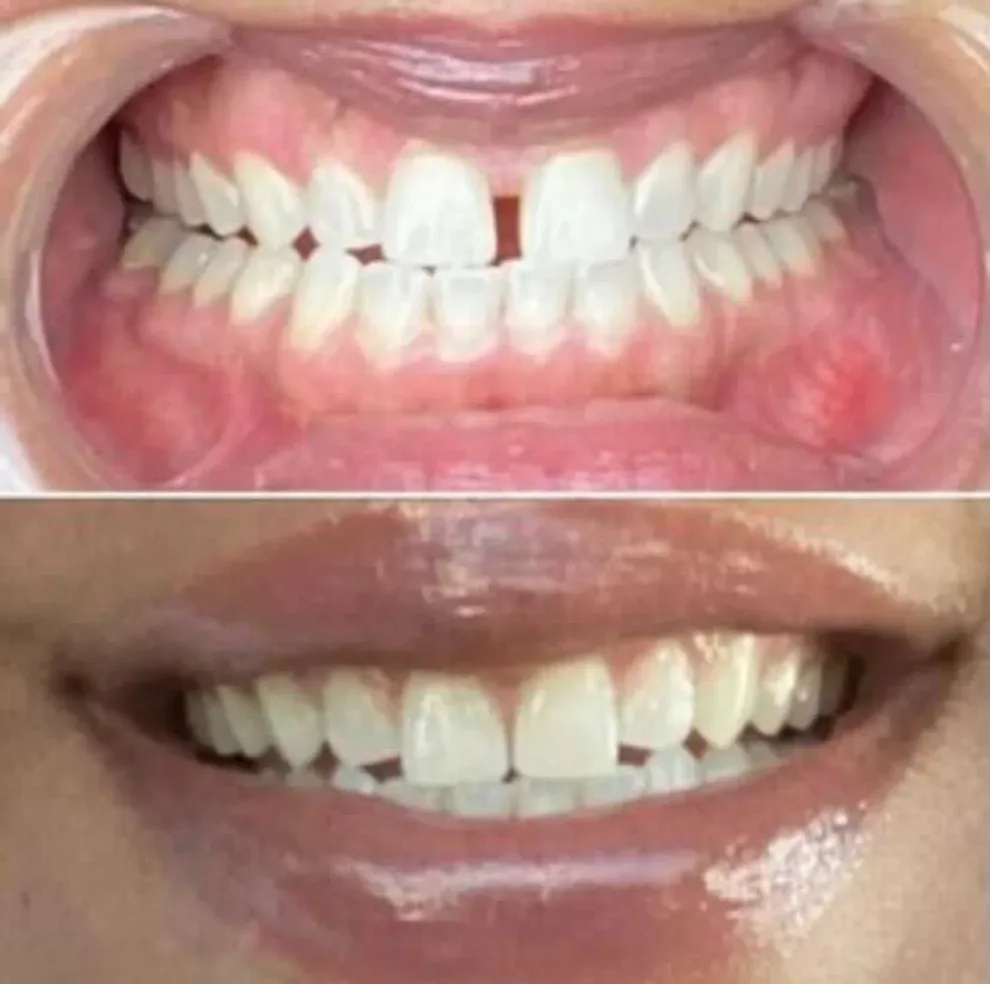Fix Teeth Gaps Without Braces (Easier Than You Think)

Table of Contents
- Why Fix your Gap Teeth?
- Are Braces Necessary?
- When Do Braces Make Sense?
- 5 Common Treatments
- Aligners for Gap Teeth
- Will Insurance Cover Treatment
- What Causes Gapped Teeth?
- FAQs
Gaps can form anywhere along your smile. They're often most noticeable when they crop up between your top two teeth. The gap gleams each time you smile, talk, or eat. And sometimes, that space allows fluids to fly out of your mouth at the most inopportune times.
Braces can help to correct gapped teeth. But there are several competing tools, including crowns, bonding, veneers, and aligners that can do the job just as well. And sometimes, these alternative treatments come with a lower price tag and less pain than braces.
What Causes Gapped Teeth?
A gap between your teeth can develop for a variety of reasons, including some you can prevent and others you can’t.
Common issues that can cause tooth gaps include the following:
Excess tissue: A labial frenum is a band of tissue that starts on the underside of your lip and attaches to the gums between the front teeth. If this band is too large, it could cause a gapping in your teeth.
Habitual behaviors: Doing things like sucking your thumb or thrusting your tongue against the back of your teeth can cause a gap.
Dental problems: If you’ve lost a tooth due to infection or accident, your other teeth could move, and a gap can appear.
Why Fix your Gap Teeth?
In some cultures, gaps are considered lucky, unusual, or beautiful. But in the United States, many people opt to fix a smile with gaps. In one informal study, a dentist reported that 6,000 new patients in one year requested a gap closure.
Gaps are attention-getting. If you want people to notice your beauty, rather than homing in on one part of your mouth, seeking out smile help makes sense.

Gaps can also lead to problems, such as these:
Trapped food: A gap can collect tiny particles of each meal you eat. That material can break down and cause gum irritation, gingivitis, or even periodontitis. Your gums may feel sore, they might look red, and they could bleed when you brush them. If left untreated, this condition can lead to deep infections.
Decay: Just as trapped food can harm your gums, it can hurt your teeth too. Food trapped close to your teeth can break down and provide sugars that plaque cells need. Your decaying teeth could require fillings or root canals.
Speech disorders: Tongues tap on teeth. When the muscles hit dead air — like the space between gapped teeth — hard consonants and other sounds don't come through clearly.
Chewing disorders: Gaps often mean teeth don't meet correctly, and that could make biting tough. Jaw muscles that work too hard can become strained, leading to headaches and upper backaches.
Weakened enamel: If the gaps in your teeth are caused by misalignment, it could mean that your bite is off. Malocclusion (teeth misalignment) can cause enamel wear if teeth aren’t aligning properly and it’s causing tooth abrasion. Weakened enamel can increase your risk of tooth damage, decay, and even tooth loss.
Braces aren't Always Necessary
Experts say that braces are common solutions for gapped teeth. Doctors glue brackets to the front of your teeth, and that hardware is connected by wires that tighten. Sign up for this treatment, and your gap will disappear. But it isn't right for everyone.
Braces come with significant risks, including:
It's hard to clean around the wires and brackets that cover your teeth.
Hardware can scrape and injure your tongue and lips.
When your mouth hurts, it's hard to eat properly.
Braces can cost thousands, and the treatment isn't always covered by insurance.
When Do Braces Make Sense?
Dentists have plenty of other options they can use to treat a gapped smile. In fact, in a study of treatments for gapped teeth, five methods were mentioned. Not one of them involved braces.
Braces are good solutions for people with significant dental problems, dentists say. If your gaps are compounded by significant crowding of your other teeth, for example, or you have multiple gaps all along your jawline, you might need significant smile interventions. Braces could be a smart choice.
But braces aren't right for every mouth. And you have plenty of treatment options to choose from.
5 Common Ways Experts Treat Gaps in Teeth Without Braces
Walk into a dental office, and ask for a better smile. The person you talk to has an array of options to share with you.
Your dental expert might recommend:
Crowns are caps that go over your teeth to protect or repair a damaged tooth, or to provide a new look and shape to the tooth. Crowns are not usually used for cosmetic purposes alone, but if the tooth needs a crown anyway, it may be helpful to close a gap.
For minor gaps, crowns might be placed over each tooth on both sides of the gap with a fuller shape, creating even-looking teeth and minimizing the appearance of the gap. For gaps that are caused by a missing tooth, crowns might be applied to the tooth on each side of the gap to provide strength and structure for a restorative procedure like a bridge.
Crowns can cost around $800 to $1,500 per tooth, largely depending on the crown material chosen. For example, porcelain crowns are more expensive than metal crowns.
Dental bonding is an exceptional way to close the gap between two front teeth. Dentists start by looking for resin that matches the color of your surrounding teeth.
With the right materials selected, the front teeth are etched very lightly, so they’ll hold more glue. The adhesive is applied, and the tooth-colored resin is applied, molded, and smoothed into the proper shape. Dentists use light to cure (or fix) the resin and ensure it bonds to the tooth. Then, the material is shaped and polished again.
Dental bonding takes just a few hours, and it’s fully reversible. If you don’t like how it looks, you can go back to your dental professional and ask for a removal. Bonding may cost $300 to $600 or more per tooth, and results typically last up to 10 years.
Dental veneers are shell-like products that are glued to the surface of your teeth. They’re typically made of porcelain or composite materials, and they’re made to be durable and resistant to staining.
Dental veneers involve several steps. In the first visit, your doctor will take impressions of your tooth and remove a tiny bit of material to make your veneers. You’ll leave this visit with temporary veneers. At the next appointment, your temporary veneers are removed, and the permanent versions are glued to your teeth.
Dental veneers are not reversible, as the doctor needs to scrape and cut the tooth to ensure the products stay put. If your veneer cracks or breaks, you’ll need the entire item replaced. Doing things like chewing on pens or your nails can make them crack faster. Veneers may cost around $800 to $1,800 or more per tooth, and they typically last 5 to 10 years.
A tooth gap band is a do-it-yourself type of orthodontic treatment in which an elastic or rubber band is placed around the two teeth on the sides of the gap in order to apply pressure for the two teeth to move closer to each other and minimize the gap. This kind of treatment is widely advised against by the dental and orthodontic community.
Tooth gap bands can cause damage to the gums and jaw and should be avoided.
If your gap is caused by a missing tooth or teeth, dental implants may be an option for restoring your bite and smile. With dental implants, a metal screw-like post replaces tooth roots, and a realistic artificial tooth replaces the missing tooth. Bone then develops around the implants to provide strength and stability.
Dental implants require a long and involved process. They are not used just to correct tooth gaps.

Aligners for Gap Teeth
Aligners offer the opportunity to amend a gap between teeth without a significant cash outlay. You could get the smile you want without breaking your budget.
Doctor-supervised aligners, like those prescribed through the Byte telehealth platform, can come with a small price tag of under $2,000.
Aligners work well for people with small to medium gaps in otherwise healthy teeth. And it's easy to get started. Often, you can make impressions of your teeth at home and send them in to get custom aligners made. For those hoping for corrections with a low price tag, this could be the right solution.
Will Insurance Cover Treatment for Fixing a Gap in Teeth?
Whether or not your dental insurance will cover treatment of your gap teeth will depend on your policy and the cause of your tooth gap.
If you have coverage for orthodontic treatment, and your gap is caused by an orthodontic issue like teeth misalignment (malocclusion), some or all of your treatment may be covered, particularly if it’s braces or aligners.
Treatment coverage may also be available if the gap is causing dental problems, like gum irritation or tooth abrasion, or in cases requiring the restoration of missing teeth.
While orthodontic and restorative treatment may be at least partially covered by some dental insurance plans, cosmetic procedures will most likely not be covered. An exception to this may be cosmetic procedures that are used to fix a gap that has been caused by an accident or injury.
Frequently Asked Questions
These are the questions we often hear about how to fix gap teeth:
It can be. A large gap can collect food and debris, leading to tooth decay and gum disease. If your gap is accompanied by jaw misalignment, you can also develop neck pain and jaw discomfort.
It depends. Some people use orthodontic devices like braces and aligners to close gap teeth. Others use veneers and dental bonding to close gaps quicker. Your dental professional can help you decide which form of treatment is right for you.
Sometimes. Young people often develop gapping in their teeth as their baby teeth come out and the adult versions appear. However, gapped teeth that show up after things like orthodontic treatment or trauma rarely fade without help.
No. Don’t use things like rubber bands or wires to push your teeth together. Talk with a dental professional about your treatment options and choose the right one together.
